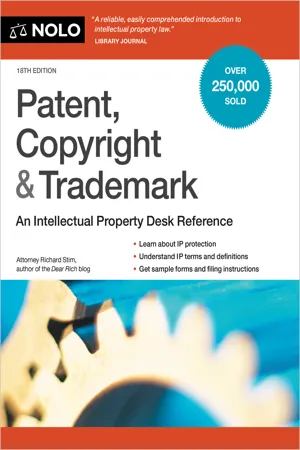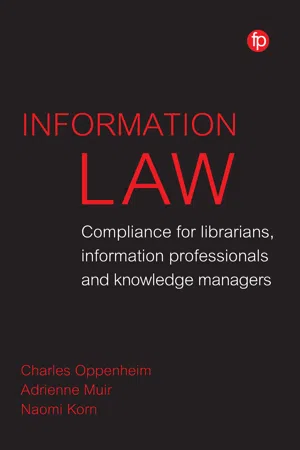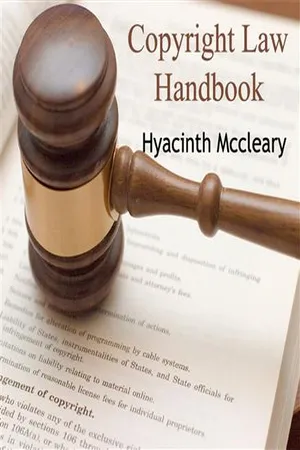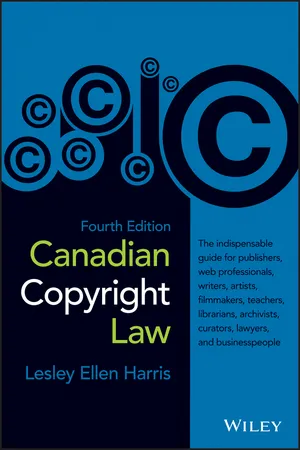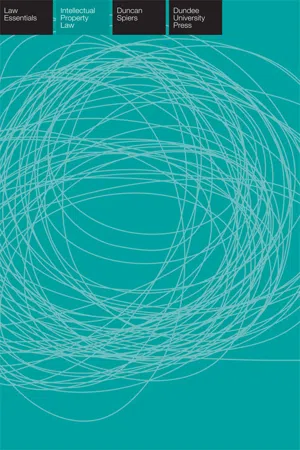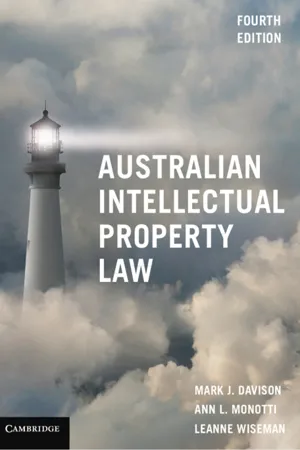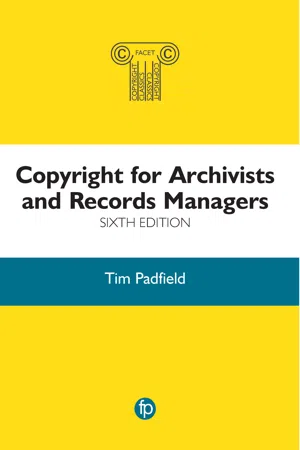Law
Copyrights
Copyrights are legal protections granted to the creators of original works, such as literary, artistic, and musical creations. They give the creators exclusive rights to reproduce, distribute, and display their works. Copyrights provide a way for creators to control the use of their works and to benefit financially from their creations.
Written by Perlego with AI-assistance
Related key terms
1 of 5
10 Key excerpts on "Copyrights"
- eBook - PDF
Patent, Copyright & Trademark
An Intellectual Property Desk Reference
- Richard Stim(Author)
- 2024(Publication Date)
- NOLO(Publisher)
190 Copyright Law: What’s New Since the Last Edition? ........................................... 191 Copyright Law: Definitions......................................................................................................... 201 Copyright Law: Forms ..................................................................................................................... 377 Preparing a Copyright Application............................................................................................... 377 Preparing an Electronic (eCO) Copyright Application ...................................................... 381 Submitting Deposit Copies ......................................................................................................... 382 Preparing a Traditional Print Copyright Application ......................................................... 383 Copyright Law: Overview C opyright law protects writing, music, artwork, computer programs, photo- graphs, and other forms of artistic expression. Under copyright law, the creator of an original work (known as the author) is granted the exclusive right to make copies and prevent others from copying or creating a derivative work (a work derived from or based on the artist’s protected work). Below is a summary of copyright basics. What is a copyright? A copyright gives the owner of a creative work the right to keep others from unau- thorized use. Under copyright law, a creative work (often referred to as a “work of authorship”) must meet all of these three criteria to be protected: • It must be original—the author must have created rather than copied it. • It must be fixed in a tangible (concrete) medium of expression—for example, it should be recorded or expressed on paper, audio or videotape, computer disk, clay, or canvas. • It must have some creativity—that is, it must be produced by an exercise of human intellect. There is no hard and fast rule about how much creativity is enough. - eBook - PDF
Information Law
Compliance for librarians, information professionals and knowledge managers
- Charles Oppenheim, Adrienne Muir, Naomi Korn(Authors)
- 2020(Publication Date)
- Facet Publishing(Publisher)
Introduction Copyright is the exclusive and assignable legal right, initially given to the author of an original work for a fixed number of years, to reproduce, print, publish, disseminate electronically, perform, or record their creative material. The word ‘initially’ is used, as the author can and often does assign the copyright, i.e. transfer the copyright ownership, to a third party, such as a publisher. Assignment is discussed further below. In order to use copyright materials, you have to know what it is and the difficulties and opportunities copyright can create. In the UK, copyright law is primarily based on the Copyright, Designs and Patents Act 1988 and subsequent revisions, including the Copyright and Related Rights Regulations 2003, SI 2003/2498, various Copyright Rights in Performances Regulations 2014, some sections of previous Copyright Acts 1911 and 1956, various European Union (EU) Directives (most of which have been transposed into UK law by means of Statutory Instruments), international treaties that the UK has signed up to and case law from UK Courts and the European Court of Justice (ECJ). 1 The key points to note about copyright are as follows: ◆ Copyright is an economic right granted exclusively to the creator(s) of an original work, which must be in some tangible or fixed format, to either permit or to prevent other people from copying, and doing 1. At the time this book was written, the UK was still a member of the European Union and ECJ decisions applied to it. If the UK does leave the EU, future ECJ decisions will not automatically apply in the UK, though in practice, we expect UK courts will often still follow the decisions taken by the ECJ. Copyright and related rights 1 certain other things (known as ‘restricted acts’ – see further discussion below), to it. - eBook - PDF
- Michael F. Flint(Author)
- 2014(Publication Date)
- Butterworth-Heinemann(Publisher)
These two quotations contain as clear exposés of the nature of copyright as is to be found anywhere. As the word itself implies, copyright is literally a right to prevent other people copying an original work. It should be noted that it must be an original work, not an original idea. As for the word 'work', which appears frequently throughout this book, only the types of 'work' which the Copyright Act says may have copyright protection, are entitled to it. Not everything which could be described as being a 'work' is entitled to copyright. Therefore this word is used in this book in the technical sense given to it by the Act — a matter treated in more detail in chapter 2. 1.04 Intellectual property and copyright The main difficulty in comprehending copyright seems to be the association that is made between copyright, patents and trade marks. These diverse creatures are, for convenience, usually grouped together under the headings of 7 1.05 The nature of copyright 'industrial property' or 'intellectual property'. It is certainly approp-riate to include design copyright — which is registrable unlike any other form of copyright — under these generic headings, but whilst copyright certainly is a form of property, it is arguable that it would be preferable to group copyright together with passing off, breach of confidence and invasion of privacy. 1.05 The copyright statutes The law of copyright is now entirely contained in the Copyright Act 1956 and the Copyright (Amend-ment) Act 1971. The law relating to industrial design is contained in the Registered Designs Act 1949 and the Design Copyright Act 1968. The Dramatic and Musical Performers' Protection Act 1958 and the Performers' Protection Act 1963, whilst not dealing specifically with copyright, have given protection to performers in a way which has almost the effect of creating rights analagous to copyright. - No longer available |Learn more
- (Author)
- 2014(Publication Date)
- University Publications(Publisher)
According to Graham Dutfield and Uma Suthersanen copyright is now a class of intangible business assets, mostly owned by companies who function as investor, employer, distributor and marketer. While copyright was conceived as personal property awarded to creators, creators now rarely own the rights in their works. Copyright and authors Copyright law emerged in 18th Century Europe in relation to printed books and a new notion of authorship . In the European Renaissance and Neoclassical period the writer was regarded as an instrument, not as an independent creator. The writer was seen as using external sources to create a work of inspiration. In the 18th Century a changing concept of genius located the source of inspiration within the writer, whose special talents and giftedness was the basis for creating works of inspiration and uniqueness. The concept of the author as original creator and owner of their work emerged partly from the new concept of property rights and John Locke's theory that individuals were owners of themselves. According to Locke individuals invested their labour into natural goods, and so creating property. Authors were argued to be the owners of their work because they had invested their labour in creating it. According to Patterson and Livingston there remains confusion about the nature of copyright ever since Donaldson v Beckett, a case heard in 1774 by the British House of Lords about whether copyright is the natural law right of the author or the statutory grant of a limited monopoly. One theory holds that copyright's origin occurs at the creation of a work, the other that its origin exists only through the copyright statute. Copyright and competition law Copyright is typically thought of as a limited, legally sanctioned monopoly. Because of this, copyright licensing may sometimes interfere too much in free and competitive markets. - eBook - ePub
- Lesley Ellen Harris(Author)
- 2013(Publication Date)
- Wiley(Publisher)
Chapter 9
Rights Protected by Copyright
It’s why you create characters: so you can argue with yourself. —Michael OndaatjeThe Nature of Rights Granted by the Copyright Act
Rights are acts that only a copyright owner may do, or authorize others to do, with protected material. Anyone who exercises a right without the copyright owner’s permission is violating copyright and may be subject to a number of remedies set out in the Copyright Act. The remedies are discussed in Chapter 13. Legally using content is discussed in Chapter 14.This chapter examines three kinds of rights set out in the Copyright Act: economic rights, moral rights, and rights in other subject-matter (called neighbouring rights). Copyright protects the economic interests of the creators and owners of literary, dramatic, musical, and artistic works. Moral rights protect the integrity of a work and the identification of its creator. Neighbouring rights protect the rights of performers (including their moral rights), broadcasters, and makers of sound recordings.Copyright versus Moral Rights
Moral rights must be distinguished from copyright. In order to do this, think of copyright as economic rights; that is, those rights that can be exchanged for money. An example of economic rights is where an author grants to a publisher the right to publish his or her book in exchange for a royalty payment. These economic rights, or copyright, include a myriad of rights, or a bundle of rights such as the right to publish, reproduce, perform in public, broadcast, translate a work, and so on, as well as the right to authorize or permit any of these acts. An author has the right to “exploit” these rights in any manner he or she chooses, and the right to be monetarily compensated for such exploitation.Moral rights are different from the economic rights of copyright. The purpose of moral rights is to protect the honour and reputation of a creator. Moral rights are closely related to the personality of an author. Moral rights cannot be exercised by any person other than the author (or an heir), and cannot be exchanged for money. - eBook - PDF
- Duncan Spiers(Author)
- 2019(Publication Date)
- EUP(Publisher)
Copyright in typographical arrangements lasts for 25 years from the end of the year in which the arrangement was published. Copyright in artistic works which have been industrially exploited lasts for 25 years (s 52 of the 1988 Act). Moral rights last as long as the Copyrights last, except for false attribution right which lasts for 20 years from the end of the year in which the author dies. Database rights last for 15 years from the end of the year in which the database was first made available. Essential Facts • Copyright is the right that an author has to prevent their work from being reproduced – usually to the economic detriment of the author. • Protected works involve the author’s expression of his ideas in a fixed form. The ideas themselves are not protected. • The principal categories of work that are protected are original literary, dramatic, musical and artistic works. These are often referred to as “primary” or “authorial” works. “Secondary” or 18 INTELLECTUAL PROPERTY LAW “derivative” works are also protected. These are sound recordings, films (including their soundtracks), broadcasts and typographical arrangements. • Literary works are works consisting of words (whether written, printed, spoken or sung). The works must be of sufficient length to indicate some merit, inventiveness, entertainment or instruction. A literary work also includes a table, compilation, computer program or database. • A dramatic work is a work of action and including dance and mime but excluding words (which are covered by literary works protections). • Musical works involve sounds (usually instrumental) whose form is controlled by the instructions of the composer (but again excluding words). • Artistic works includes a very broad range of creative materials (including graphic works, photographs, sculptures, collages, works of architecture and works of artistic craftsmanship). The first four of these categories are protected regardless of artistic quality. - eBook - PDF
- David Kline, David Kappos(Authors)
- 2021(Publication Date)
- Openstax(Publisher)
copyright law are limited only to certain works of visual art but under European copyright statutes are more broadly applied to other kinds of copyrightable work. Derived from the French concept of droit d’auteur, these give authors the power to protect the integrity of their work as well as the right of attribution. xix Preserving the integrity of a work means that the author has the right to prevent its intentional distortion, mutilation, or modification by others. Authors also have the right to control the use of their name in relation to the work. Both of these rights, however, have limitations. Under U.S. law, because moral rights are personal, they exist only for the life of the author. Only the author can enforce those rights; they cannot be transferred by the author to heirs or anyone else. As noted at the beginning of this chapter, registration is not required in order to enjoy copyright protection. Once an author puts words to paper, paint to canvas, or software code into a digital file, it is immediately protected by copyright and nothing more is required. Although the requirement of registration as a condition of federal copyright protection was discarded over a century ago, when Congress passed the Copyright Act of 1909, the requirement that proper copyright notice be affixed to copies of published works survived much longer. It was only dropped in 1989, when the United States joined the Berne Convention and had to amend its copyright law to comply with the terms of that convention. Notice and registration of copyright are now discretionary, but recommended. Registration of a copyright provides a legal record of copyright ownership in cases where infringement is alleged, and in fact is required before the author can even file suit for infringement. xx To register a published work, an author will usually need to submit two copies of the work to the U.S. - Tim Padfield(Author)
- 2015(Publication Date)
- Facet Publishing(Publisher)
However, some quite insubstantial things, such as newspaper headlines, chapter headings and titles, have been found capable of being original (see 2.1.6), and so capable of being copyright works in their own right. Whether they do in fact qualify depends on the level of creativity involved. Similarly, a form which has taken much skill to design might be protected, as might a suite of relatively simple forms. There is no copyright in a personal name: anyone may adopt another’s name without infringement of copyright. The courts have found that a signature is too trivial to qualify as a literary work, but that it might qualify as an artistic one (see 2.3.2). Du Boulay v Du Boulay, 1869; Dicks v Yates, 1881; Lamb v Evans, 1893; Libraco v Shaw Walker, 1913; Francis, Day & Hunter v Twentieth Century Fox, 1940; Capital Finance v Bowmaker, 1964; Ladbroke (Football) v William Hill (Football), 1964; Exxon Corporation v Exxon Insurance, 1982; Elvis Presley Trade Marks, 1997, at 558; Newspaper Licensing Agency v Meltwater, 2012 COPYRIGHT PROTECTION 25 2.1.17 The author In most circumstances, the author is the person who creates the work, and is the first owner of the copyright in it. The circumstances where the author is not the first owner are considered in Chapter 3. The definition of the ‘author’ depends on the nature of the work in question, as discussed for each category below (see 2.2.6–15, 2.3.6–11, 2.4.3–8, 2.5.4–5, 2.6.6–9, 2.6.14, 2.6.16), and can be more than one person (see 2.2.14, 3.2.7–9). The identity of the author is important, even if he or she is not the first owner and regardless of any assignments of ownership, since the term of copyright normally depends on the length of his or her life.- eBook - PDF
- Mark J. Davison, Ann L. Monotti, Leanne Wiseman(Authors)
- 2020(Publication Date)
- Cambridge University Press(Publisher)
8 Moral rights are personal to the creator. They are non- economic rights that are distinct from copyright and are often justified on similar non-economic grounds. 9 As with many legal regimes, moral rights perform, or at least are said to perform, a number of different roles. At the most general level, they provide a limited form of protection for authors and their works. This is particularly important where creators no longer own copyright in their works, or where they ‘no longer own the physical items in which their copyright is embodied, and ... therefore do not have an opportunity to contract with users for the protection of those rights’. 10 Moral rights, unlike copyright, cannot be assigned; however, authors may ‘consent’ in writing to infringements of their moral rights. 11 Moral rights are also meant to ensure that people who make use of artistic and cultural creations do so in a manner that is respectful to the interests of the creator. Moral rights also play a role in protecting and promoting the author’s or creator’s reputation. Australian law recognises three moral rights: the right of attribution of authorship, the right of integrity of authorship and the right to prevent false attribution. 12 Except in the case of the makers of cinematograph films and sounds recordings, all moral rights continue in force until copyright ceases to exist in the work. 13 When the author of a work dies, the author’s moral rights may be exercised and enforced by the author’s legal personal representative. 14 In relation to cinematograph films, the moral rights are held by the director, producer and ................................................................................................................................................................................................................................. 6 For more detailed discussion of moral rights, see E. - Tim Padfield(Author)
- 2019(Publication Date)
- Facet Publishing(Publisher)
2 Copyright protection 2.1 Protection for works 2.1.1 Types of work Copyright law classifies works into defined types, for which the provisions differ. For archivists and records managers the most important are literary, dramatic, musical and artistic works, films and sound recordings. Other types of work (broadcasts and typographical arrangements) present problems less often. The definitions themselves have varied with successive legislative changes, but those in the 1988 Act (as subsequently amended) normally apply to all works created before and still in copyright at commencement and are thus the only ones that need be of concern for most purposes. Cases where earlier definitions still apply (notably pre-1912 maps, see 7.14.2–3, and pre-1957 films, see 2.4.1) are set out in the descriptions of the appropriate categories. 1988 (CDPA) Sch 1 para 3 2.1.2 The nature of works A single item may consist of more than one work, of different types. An academic journal, for instance, might contain several articles, each of which could be a separate literary work, together with illustrations, each of which could be a separate artistic work, and some music, which could be a musical work. The journal as a whole might qualify for protection as a compilation (see 2.1.10, 2.2.3), and will certainly have protection for its typographical arrangement (see 2.6.15). Similarly a song consists of music and words; each has its own copyright and there is no distinct copyright in the song as a whole although the same person may be the author of both (however, see 2.2.14). Also, each separate entry in a diary is a separate copyright work while the diary as a whole is another. In an archive, deeds, for instance, are primarily literary works, but any plans in or on them are separately protected as artistic works.
Index pages curate the most relevant extracts from our library of academic textbooks. They’ve been created using an in-house natural language model (NLM), each adding context and meaning to key research topics.
